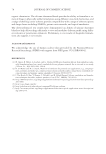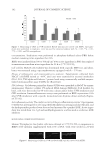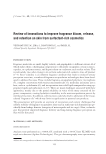J. Cosmet. Sci., 68, 11–23 ( January/February 2017) 11 Investigation of water-soluble elastin as a multifunctional cosmetic material: Moisturizing and whitening effects ASAKO INOUE, TOMOHIRO HIKIMA, SUGURU TANIGUCHI, TAKERU NOSE, and IORI MAEDA, Department of Bioscience and Bioinformatics, Kyushu Institute of Technology, Iizuka, Fukuoka 820-8502 (A. I., T. H., S. T., I. M.) and Faculty of Arts and Science, Kyushu University, Fukuoka, 819-0395 (T. N.), Japan. Accepted for publication December 23, 2016. Synopsis Elastin and collagen are extracellular matrix proteins that are widely distributed in the body. Although elastin essentially functions as a skin moisturizer, there have been few reports on its other fundamental chemical and biological functions. In this study, we investigated the moisturizing and whitening (tyrosinase inhibition) effects of elastin to examine its usefulness as a cosmetic material. Water-soluble hot alkali pig aorta (HAPA)- elastin was prepared from pig aorta using the hot alkali method. HAPA-elastin showed a widely distributed molecular weight and had a coacervation property that mediated reversible self-assembly of its molecules with increasing temperature. Amino acid analysis of HAPA-elastin showed a high content (81.5%) of hydrophobic amino acids such as Gly, Ala, Val, and Pro. Des (desmosine) and Ide (isodesmosine), which are characteristic amino acids of elastin, accounted for more than 0.4% of the total amino acid content. HAPA-elastin showed a moisture-retaining property. The water content of skin samples treated with and without HAPA-elastin was 77.2% ± 7.8% and 49.4% ± 10.1%, respectively. HAPA-elastin also inhibited tyrosinase activity by 11.3% ± 3.9%. The results obtained indicate that elastin has a useful function as a cosmetic material. INTRODUCTION Elastin is an extracellular matrix protein, which imparts elasticity to connective tissues such as ligaments, arterial walls, lungs, and skin (1). The reversible self-assembly of elastin molecules, which is temperature dependent, is termed “coacervation.” This characteristic is important for the formation of mature elastin and the expression of elasticity in elastic tissues. Elastin plays principal roles in achieving elasticity in the body. It is important to maintain the elastin content in human tissues however, the elastin content decreases owing to various factors such as aging (2). Therefore, increasing and sustaining the content of elastin in tissues can contribute to the maintenance of health and beauty. It has been reported that ingesting water-soluble elastins prepared from several animal sources has a positive infl uence on the human health and beauty. For example, ingestion of water-soluble elastin improved the skin condition, such as improvement in texture and moisture of skin (3,4). Address all correspondence to Iori Maeda at iorinose@bio.kyutech.ac.jp.
JOURNAL OF COSMETIC SCIENCE 12 Various compounds have been applied as cosmetic materials to improve the skin condi- tion. Recently, some cosmetics containing amino acids such as Gly, Ala, and Pro, which are abundantly present in elastin, have been noted to preserve the skin moisture. These amino acids maintain a healthy skin condition and have moisturizing effects (5–7). Several elas- tins prepared from bovine ligamentum and porcine aorta show distinctive amino acid compositions and are rich in hydrophobic amino acids, Gly (30–36%), Ala (23–25%), Val (10–13%), and Pro (9–12%). These amino acid compositions are characteristic of the elastins and retain the skin moisture (8). Elastin is widely distributed in the body and is known to be almost nonantigenic (9). The abovementioned features of elastin make it a favorable cosmetic and medicinal material. There are growing numbers of elastin-containing cosmetic products on the market, vali- dating the moisturizing action of elastin. However, there are only a few reports explain- ing the fundamental chemistry of elastin as a useful cosmetic compound (3,4). Therefore, we investigated whether elastin has other desirable effects as a cosmetic material, such as whitening effect that has not been reported. In this study, we used hot alkali pig aorta (HAPA)-elastin (water-soluble elastin), which was prepared from pig aorta and was a mixture of elastin, and its degradation products. This material is sold as an ingredient for functional foods. The molecular weight distribution and amino acid composition of the elastin fractions of HAPA-elastin were examined to iden- tify their cosmetic characteristics. We focused on the moisturizing and whitening effects of HAPA-elastin. We also studied its moisture-retention effect using a three-dimensional cultured human epidermis, as well as its in vitro inhibitory effect on tyrosinase activity. MATERIALS AND METHODS MATERIALS Water-soluble HAPA-elastin (Farm elastin® for cosmetics, E&C HealthCare Ltd. Ka- goshima, Japan) prepared from pig aorta by the hot alkali hydrolysis method was a kind gift from E&C HealthCare Ltd. We purchased both 3,4-dihydroxy-L-phenylalanine (DOPA) and “tyrosinase from mushroom” from Sigma-Aldrich (St. Louis, MO). All other chemicals were purchased from Wako Pure Chemical Industries Ltd. (Osaka, Japan). AMINO ACID ANALYSIS HAPA-elastin was hydrolyzed using 6 M HCl for 48 h at 110°C in vacuo. After hydrolysis, the samples were dried and redissolved in 0.02 M HCl. Amino acid analysis was carried out with an amino acid analyzer (JLC-500/V, JEOL Ltd., Tokyo, Japan), using lithium buffers at an increasing pH. The analysis was performed at Yamaguchi Prefectural Indus- trial Technology Institute (Yamaguchi, Japan). GEL FILTRATION CHROMATOGRAPHY The gel fi ltration chromatography was performed on a 1220 Infi nity LC System (Agilent Technologies, Santa Clara, CA) using a TSK gel G2000 SWXL column (7.8 × 300 mm, 5 μm Tosoh Co., Tokyo, Japan). The mobile phase was 50 mM phosphate buffer containing
Purchased for the exclusive use of nofirst nolast (unknown) From: SCC Media Library & Resource Center (library.scconline.org)












































































































































